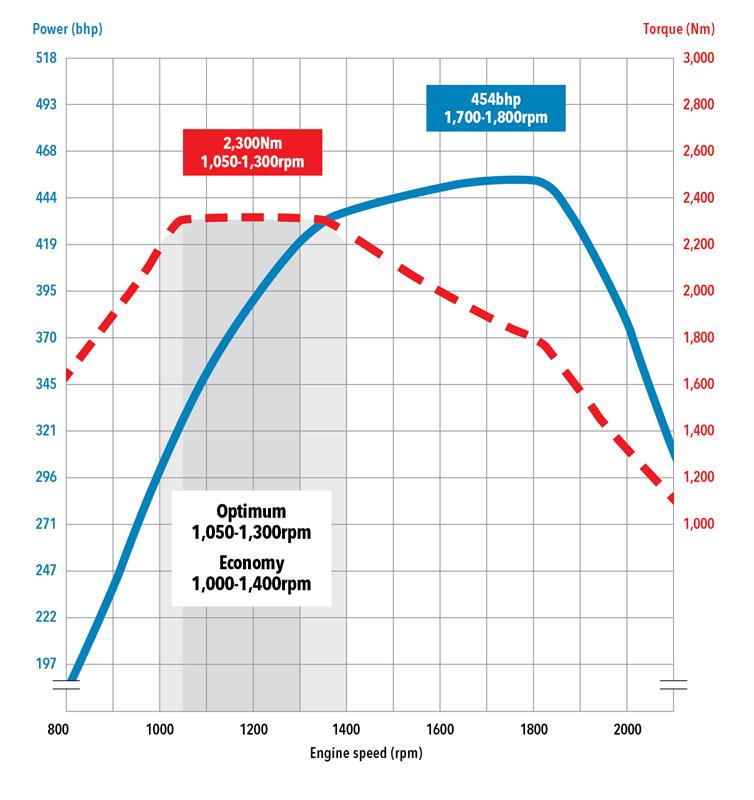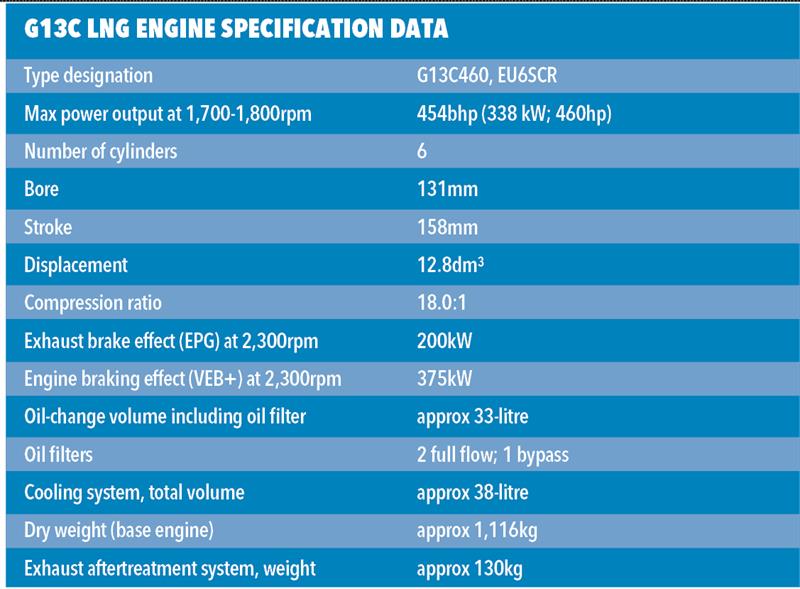Volvo’s FH and FM LNG (liquefied natural gas) tractors draw on the Volvo G13C LNG engine for performance on par with standard diesels with the same power rating, but emitting 20% less CO2.
From the head gasket down, Volvo’s G13C LNG engine is based on its 12.8-litre, D13K Euro VI diesel power plant. Available in 414 and 454bhp outputs, with 2,100Nm and 2,300Nm of torque respectively, the G13C can be fitted to FM and FH models. Designed for heavy long-haul and distribution operations, the G13C is a 454bhp, 12.8- litre, in-line six-cylinder gas engine equipped with an overhead camshaft, four valves per cylinder and common rail fuel injection. Gas engines like the G13C460, with the diesel principle, can achieve higher horsepower and torque by using direct injection and relying on heated compression for ignition. Therefore the principal characteristics are similar to a diesel engine.
A low-emission engine in terms of both exhaust gases and noise, the G13C has the same aftertreatment system as Volvo’s D13K Euro VI diesel engines. Another similarity is the fitment of VEB+ (Volvo engine brake.) As per the D13K, Volvo’s G13C LNG engine maximises use of high compression ratios to deliver an effective engine compression brake, something that Otto cycle spark-ignition CNG engines lack, with their attendant lower compression ratios. Average spark ignition compression ratios come in at 10:1-14:1, while diesels utilise a higher 18:1-23:1 average. This, along with an optional retarder, provides high braking effects, further improving safety and in turn reducing wear rates on the wheel brakes. Volvo’s LNG service intervals are higher than its Otto cycle rivals at 100,000km. Externally, the engine’s biggest visual difference is an extra hydraulic pump that powers the gas pump within the tank, raising supply pressure to 300bar.
A unique fuel injector is the key difference to the G13C. Made exclusively for Volvo, this component uses two concentric needles to supply fuel from two sources at the same time. Electronically controlled, the injector is fed from a dual-compartment fuel rail. To prevent methane slip, the gas section of the rail is purged back to the tank every time the engine shuts down.
The G13C LNG’s dual fuel design requires the injection of a small (5-10%) shot of diesel, instead of a spark plug. The diesel is injected just prior to the gas, to ignite the gas injection. Gas is injected at a high pressure at the end of the compression stroke. This solution gives a robust combustion process with no premixed air/fuel, so there is no risk of knocking. The GCM (gas conditioning module) regulates the pressure delivered to the gas rail and injectors, depending on the engine operating point. Any vented gas from the GCM, at engine shutdown or during operation, is returned to the LNG tank via the RTT (return to tank) valve.
The D13K’s rear-mounted timing gears drive a power steering pump, oil pump, fuel feed pump and air compressor on the LNG power plant. Adding to the G13C’s design is a choice of two types of closed crankcase ventilation (CCV), although one is only for Arctic markets.


The G13C’s gas supply system sees LNG contained in the chassis tank pumped through an integrated evaporator, before then being discharged as a high-pressure gas. The gas then flows through an outlet check and automatic tank shut-off valves before reaching an outlet temperature sensor. Then a flexible hose provides supply to the integrated gas module. Within the latter device, pressure and temperature sensors provide a picture of conditions for the fuel regulation and control system. An over-pressure safety device protects the system against excessive overall pressure. This component also dampens excessive pressure pulses, which can result from the pump strokes of the LNG pump.